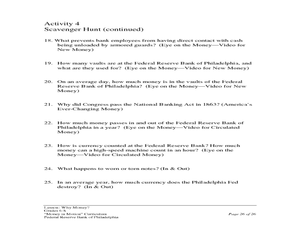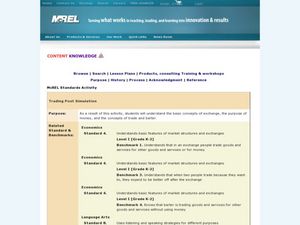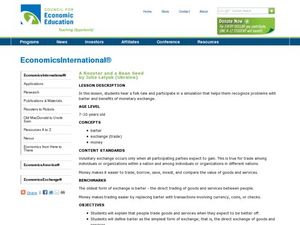Curated OER
Jamestown's Economy
Students identify items made in Jamestown and draw conclusions about their economy. For this Jamestown economy lesson, students use the internet to complete a worksheet which required them to look at photographs of goods made in and...
PBS
What Is Money?
Early learners participate in a bartering activity during which they make connections to money and consumer concepts. They simulate buying and selling situations with one another then visit an exhibit at the Federal Reserve Bank of...
Curated OER
Interdependence: A Colonial Example
Students complete a variety of activities related to Colonial America and how people lived at that time. They conduct research on a selected colonial trade and present an oral report as role-playing that craftsman, and participate in a...
Curated OER
Can't You Make Them Behave, King George?
Fifth graders describe the changes in King George III's policy toward the American colonies by sequencing key events between the French and Indian War and the American Revolution. They explain the colonial reactions to command decisions...
Curated OER
Market Simulation
Students explore the role of markets in Asian countries. They bring items from home to barter with to simulate markets. They discuss the advantages and problems of exchanging and how price is determined.
Curated OER
A Rooster and a Bean Seed
Students hear a folk tale and participate in a simulation that helps them recognize problems with barter and benefits of monetary exchange.
Curated OER
Fourth Grade Earning and Learning Podcast
While this lesson is connected to social studies curriculum that is not identified, the activity could be used as a template for a review of any material. The lesson focuses on a review of vocabulary relating to the economy. Pupils...
Curated OER
Baseball Lesson: Barter vs. Money
4th graders view this PowerPoint to recognize the difference between the monetary and barter systems. The author of this resource defines or likens Barter to a swap and misleadingly states that money was invented because bartering took...
Curated OER
What is Bartering?
This PowerPoint features information about barter and money economies. Slides provide details that allow students to draw comparisons between barter and money economies. Students discover facts about wampum and explore problems with...
Curated OER
Bartering Through the Seasons
Fifth graders explore bartering. In this bartering lesson, 5th graders investigate bartering between the American colonies. Students study the climate and geography of neighboring colonies and investigate crops native to each area.
Curated OER
Barter Day
Fifth graders research bartering. In this bartering lesson, 5th graders investigate bartering as a way to trade for goods and services. Students experience bartering first hand while playing a game.
Curated OER
Bartering for a Living: Lesson 3
Students explore the concept o bartering during colonial times. In this colonial lesson plan, students discover what it was like to live and servive during the colonial times. Students also discover how people using to barter for items...
Curated OER
A Lesson to Accompany "Benjamin Franklin and the Birth of a Paper Money Economy"
Young scholars investigate the role of money in the colonial economy. In this colonial economy lesson, students participate in a trading activity, read the booklet "Benjamin Franklin and the Birth of a Paper Money Economy," participate...
Curated OER
Why Money?
Students participate in a trading simulation to learn about barter and the benefits of using money. In this barter lesson plan, students participate in a trading simulation and learn about coincidence of wants. Students then use money...
Curated OER
Trading Post Simulation
Students explore the concept of trade. In this trade instructional activity, students simulate a trade store. Students are divided into two groups. Half the class runs the store, half the class are customers. Students try to trade goods...
Curated OER
A Rooster and a Bean Seed
Young scholars study exchange and how it has different forms. In this money management lesson, students are able to learn how goods and services work by completing worksheets, activities, essay questions and assessments provided.
Curated OER
Describe How Money Barter, and Credit Were Used in Colonial Virginia
Fourth graders listen as the teacher lectures about bartering. They work in small groups to define and create a skit about one term related to bartering. Students create an Economic Terms booklet. They review that tobacco was a cash crop...
Curated OER
What is Economics?
Students define economics; Explain the importance and process of making economic choices and decisions; Identify the factors of Production; Determine the goal of entrepreneurship. Students identify and describe the difficulties...
Curated OER
Money as a Means of Exchange
First graders discover the term bartering as used to pay for wanted items. They play a bartering game to discover exchanging goods for wanted items and play the computer money game on the "Show-Me Economics" web site.
Curated OER
African Markets: Out in the Open
Students identify advantages and disadvantages of African open air markets. They discuss the types of items sold there and why the markets are outdoors. They observe a bartering session between the teacher and another adult. Finally,...
Curated OER
Let's Make a Deal- Barter 208
Students analyze and evaluate the barter system. They discuss the barter is the proper term for making deals. They participate in a simulation to illustrate each kind of barter.
Curated OER
Rendezvous
Fourth graders research the Rendezvous. They then set up bartering stations for students from other classes to visit.
Curated OER
Why Use Money? Getting What We Need
Students learn the difference between purchase, barter, and payment for service, then explore how the Akan and North African people used a barter system to exchange gold and salt. They identify the most efficient ways of procuring your...
Curated OER
Ancient Egypt: Domestic Life: Bartering
In this ancient Egypt worksheet, students read about bartering in the marketplace. Students find the value of 4 items and draw the things you could barter them for.

























